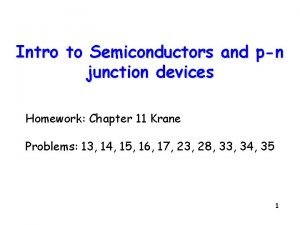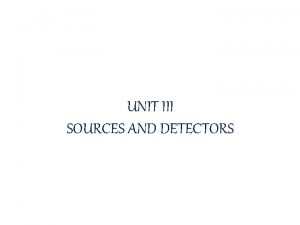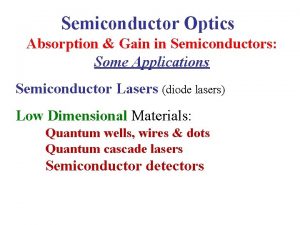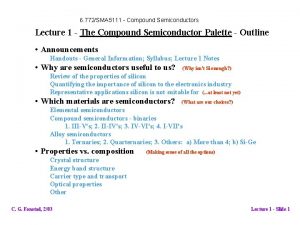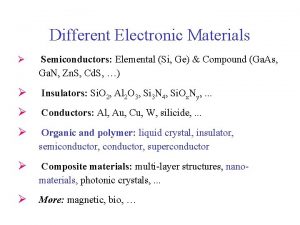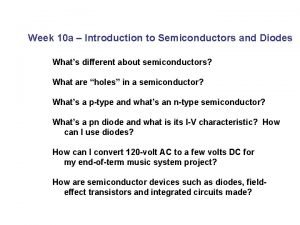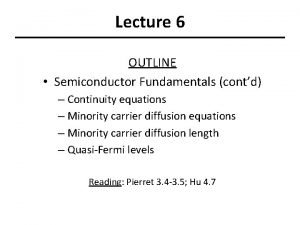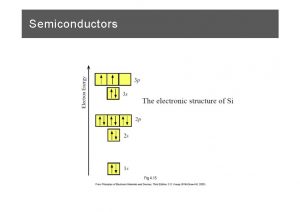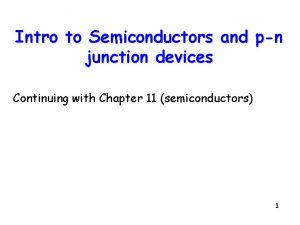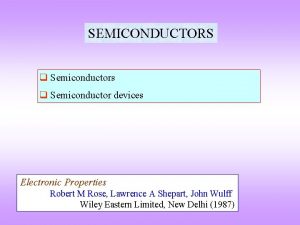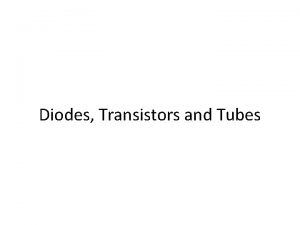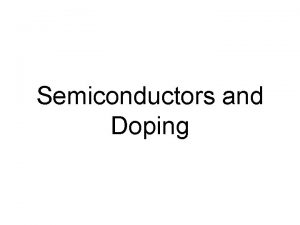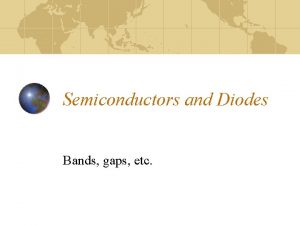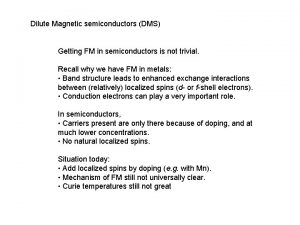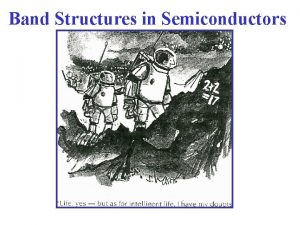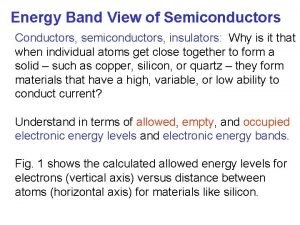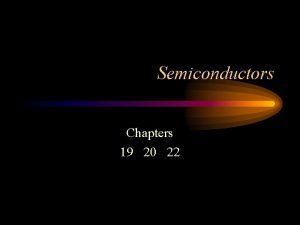Intro to Semiconductors and pn junction devices Homework















- Slides: 15

Intro to Semiconductors and p-n junction devices Homework: Chapter 11 Krane Problems: 13, 14, 15, 16, 17, 23, 28, 33, 34, 35 1

pn Junction: Band Diagram l l Due to diffusion, electrons move from n to p-side and holes from p to n-side. Causes depletion zone at junction where immobile charged ion cores remain. Results in a built-in electric field (103 to 105 V/cm), which opposes further diffusion. Note: EF levels are aligned across pn junction under equilibrium. EC EF EV n-type electrons pn regions “touch” & free carriers move EF holes p-type pn regions in equilibrium EC EF EV –– – +– – –– + + +–– –– – + ++ ++ Depletion Zone 2

Forward Bias and Reverse Bias l l Forward Bias : Connect positive of the positive end to positive of supply…negative of the junction to negative of supply Reverse Bias: Connect positive of the junction to negative of supply…negative of junction to positive of supply. 3

PN Junction: Under Bias • Forward Bias: negative voltage on n-side promotes diffusion of electrons by decreasing built-in junction potential higher current. • Reverse Bias: positive voltage on n-side inhibits diffusion of electrons by increasing built-in junction potential lower current. Equilibrium Forward Bias Reverse Bias p-type n-type e– p-type n-type –V e– Majority Carriers p-type n-type +V e– Minority Carriers 4

pn Junction: IV Characteristics l l Current-Voltage Relationship Forward Bias: current exponentially increases. Reverse Bias: low leakage current equal to ~Io. Ability of pn junction to pass current in only one direction is known as “rectifying” behavior. Forward Bias Reverse Bias Manifestly not a resistor: V=IR Not Ohm’s law 5

N-channel MOSFET Gate Drain Source n gate oxide insulator p n ID • Without a gate-to-source voltage applied, no current can flow between the source and drain regions. • Above a certain gate-to-source voltage (threshold voltage VT), a conducting layer of mobile electrons is formed at the Si surface beneath the oxide. These electrons can carry current between the source and 6 drain.

Metal-Oxide-Semiconductor FET How does it work? There is no conduction between the source and drain normally (VGS = 0) because regardless of what voltage VDS you apply there is a reverse biased PN junction. Even apply a voltage VGS does not appear from the structure to have an obvious effect since it is not even attached - there is a thin Si. O 2 insulating layer in between! 7

Metal-Oxide-Semiconductor FET(2) However when you apply a positive voltage the oxide behaves like a capacitor since positive charge builds up on one side, there must be an equal and opposite charge on the other side. This charge must come from the substrate. Since it is P-type there are not many electrons but those that are present are all sucked up to the gate oxide. This creates a region that is very thin, but very rich in electrons, converting P-type to N-type locally. This “channel” is enhanced by applying higher positive biases. 8

IG vs. VGS Characteristic Consider the current IG (flowing into G) versus VGS : S IG V + G oxide semiconductor D V + DS GS IG always zero! The gate is insulated from the semiconductor, so there is no significant steady gate current. VGS 9

ID vs. VDS Characteristics Next consider ID (flowing into D) versus VDS, as VGS is varied: S V + G oxide semiconductor ID D V + DS GS ID VGS > VT zero if VGS < VT VDS Above threshold (VGS > VT): “inversion layer” of electrons appears, so conduction between S and D is possible Below “threshold” (VGS < VT): no charge no conduction 10

The MOSFET as a Controlled Resistor l The MOSFET behaves as a resistor when VDS is low: l Drain current ID increases linearly with VDS l Resistance RDS between SOURCE & DRAIN depends on VGS • RDS is lowered as VGS increases above VT NMOSFET Example: ID VGS = 2 V VGS = 1 V > VT VDS IDS = 0 if VGS < VT 11

ID vs. VDS Characteristics The MOSFET ID-VDS curve consists of two regions: 1) Resistive or “Triode” Region: 0 < VDS < VGS VT 2) Saturation Region: VDS > VGS VT “CUTOFF” region: VG < VT 12

MOSFET regions of operation Cutoff: VGS <= VT ID = 0 Resistive: ID ~ (VGS – VT)VDS Saturation: ID ~ (VGS – VT)2 13

MOSFET Uses A MOSFET can be used as A linear amplifier: Input voltage applied between gate and source; output voltage appears between source and drain or An electronic switch: Switches between no current conduction between source and drain, and heavy conduction between source and drain as voltage applied between gate and source changes from low to high 14

Importance l l The transistor is probably the most important invention of the 20 th century…. Transistors are central to the Integrated Circuit, and therefore, all electronic devices of the information age, such as: pc’s, cellular phones, ipods, pda’s, intelligent cars and buildings……. 15
 Intro to semiconductors
Intro to semiconductors Conjunction junction what's your function meaning
Conjunction junction what's your function meaning Homework oh homework
Homework oh homework Homework oh homework i hate you you stink
Homework oh homework i hate you you stink Jack prelutsky homework oh homework
Jack prelutsky homework oh homework Homework oh homework poem
Homework oh homework poem Alitteration definition
Alitteration definition Literal and figurative language
Literal and figurative language Direct and indirect band gap semiconductors
Direct and indirect band gap semiconductors Semiconductor
Semiconductor Quarternaries
Quarternaries Elemental and compound semiconductors
Elemental and compound semiconductors Introduction to semiconductors
Introduction to semiconductors International technology roadmap for semiconductors
International technology roadmap for semiconductors International roadmap for semiconductors
International roadmap for semiconductors Derivation of continuity equation in semiconductor
Derivation of continuity equation in semiconductor
